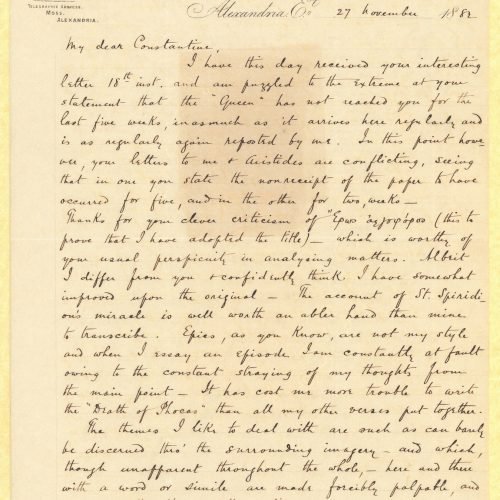υπογράμμιση
υπογράμμιση
πράσινη γραμματοσειρά
κίτρινη γραμματοσειρά
κόκκινη γραμματοσειρά
DIGITAL OBJECT DESCRIPTION
IDENTITY AREA
44 x 27.5 cm
CONTEXT AREA
CONTENT AND STRUCTURE AREA
Handwritten letter by John Cavafy to C. P. Cavafy on the first and third pages of a double sheet notepaper and on the recto of a letterhead of R. J. Moss & Co., Alexandria. Pages 2 and 3 are numbered at top right. Comments on John’s poetry. Update on current affairs.
CONDITIONS OF ACCESS AND USE AREA
English
Writing in ink. Watermark: R. J. Moss & Co Alexandria. Physical item wear: oxidations.
NOTES AREA
The transcription and editing of the letters of John Constantine Cavafy addressed to C. P. Cavafy was first carried out by Katerina Ghika; said transcriptions were subsequently uploaded to the official website of the Cavafy Archive.
The subject of the letter is John’s poetry and particularly his poems “Eros the Pain-Bearer”, “Death of Focas”, “Periplus” and “Streams”. Of note is that the title “Eros the Pain-Bearer” was suggested by C. P. Cavafy.
ACCESS POINTS
Cavafy, John Constantine. “Letter by John Cavafy to C. P. Cavafy”. Letter, 27.11.1882. GR-OF CA CA-SF02-S01-SS02-F20-SF001-0012 (387), Onassis Foundation C. P. Cavafy Fonds. From The Digital Collection of the Cavafy Archive, edited by Onassis Foundation, Athens, last modified 01.10.2025. https://doi.org/10.26256/CA-SF02-S01-SS02-F20-SF001-0012.





